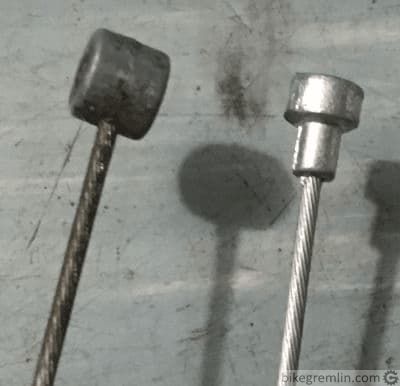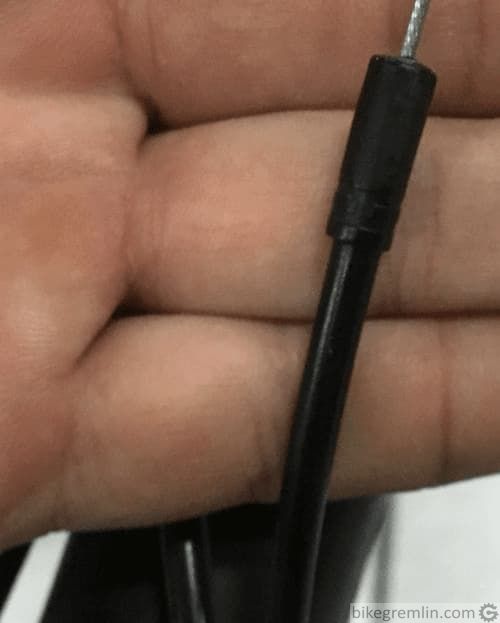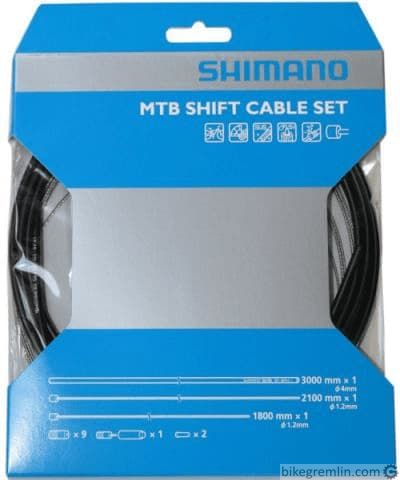Here, I’ve explained shifter and brake cable & housing standards. From my experience, many problems with poor shifting, or braking, come from using incorrect components. Separate post explains brake and shifter cable routing.
Table Of Contents (T.O.C.):
- Shifter (derailleur) cable standards – differences
- Brake cable standards – differences
- Shifter housing standards
- Brake housing standards
- IMPORTANT: difference between brake and shifter housing
- “Exotic” models
- My shopping recommendations
TL/DR
Using brake housing for shifters makes your shifting suck.
Using shifter housing for brakes is outright dangerous!
In this article, I’ve explained how to tell what is what, and gave some buying recommendations (from my decades of experience).
It’s not long – I just put many pictures to help you understand and see the differences. 🙂
1. Shifter (derailleur) cable standards – differences
Shifter cables have a barrel on one end, that is used for shifter to pull (and release) the cable, while the other end is soldered, so that wires don’t get unwinded and so that the cable can more easily be routed (and cut to the appropriate length after routing).

Picture 1
Shifter (derailleur) cables come in two standards, main difference being the end barrel, though cable thickness also tends to differ:
- Campagnolo standard – 1.1 to 1.2 mm cable diameter, with a bit smaller diameter barrel at the end
- Others (Shimano, SRAM…) – around 1.2 to 1.3 mm cable diameter – with end barrel a bit larger than Campagnolo one
Apart from the diameter, Campagnolo and Shimano shifter cables are visually almost identical, so pay attention to specifications when shopping (especially if you have Campagnolo shiters, since Shimano cables won’t fit Campagnolo shifters).

Picture 2
2. Brake cable standards – differences
To avoid/prevent any confusion, I’ll explain brake cables (and housing) as well in this post.
Brake cables come in three standards, with the main difference being the size and shape of the end barrel:
- MTB – with a large barrel on one end
- Road Shimano compatible – for Shimano and SRAM shifters
- Road Campagnolo

Picture 3
With road cables, Shimano ones have a bit larger barrel, though very similarly shaped. In fact, some manufacturers (like Jagwire, for all I know) make road bike brake cable ends such that barrels are a bit on the smaller side, hence the same model fits both Shimano and Campagnolo brake levers.

Source: bikehub.co.za forum
Picture 4
Cable thickness is about 1.5 to 1.6 mm, for both Shimano and Campagnolo.
3. Shifter housing standards
For shifter housing there are two standards:
- Shifter housing with 4 mm outer diameter.
- Shifter housing with 5 mm outer diameter (the same diameter, but not the same type, as brake housing).
All the shifter cables will run with no problems through housing by any of the above noted standards. Some MTB riders prefer 5 mm housing, since it leaves more room, so they don’t get stuck with mud that easily. Though, for 4 mm shifter housing, Shimano makes seals that prevent the entrance of dirt:

Picture 5
For 5 mm shifter housing ends, the same (metal) ends can be used as for brake housing (even though those are two different housing types!).

They look identical from the outside
Picture 6

Picture 7
Important note: Shimano seels (at least here, in Serbia) two shifter housing models:
- Shimano SP40 SIS. This one doesn’t work very well and I don’t know what it is good for. On the outside, it looks like the proper shifter housing: is only 4 mm wide (brake housing is usually 5 mm wide), and has SIS (Shimano Indexing System) written on it. But, it has a spiral steel “skeleton,” like the one used in brake housing – stronger, but more flexible.
- Shimano OT-SP41 SIS. This is the proper shifter housing. It is also 4 mm wide (outer diameter), but has the longitudinally lined steel wires, making it stiff in terms of shifter cable for-aft movement, resulting in more precise shifting. See picture 8 below for the difference between this, and brake housing “skeleton.”
SP40 does work a bit better with shifters, compared to brake housing (low-end bicycles sold locally often come with brake housing used for both brakes, and shifters). But it is still inferior to OT-SP41 in terms of shifter precision.
4. Brake housing standards
With bicycle brake housing standards there aren’t any differnces – they are all 5 mm outer diameter with steel end caps. Apart from hydraulic brake hoses, of course, but that’s a different matter.
5. IMPORTANT: difference between brake and shifter housing
Too often I see brake and shifter housing mixed. But this is not good, and can even be dangerous!
- Shifter housing is constructed to compress and elongate as little as possible with shifter cable tension change (while shifting up and down). But it can not take large force – pull cable strong enough and it will split!
- Brake housing is made to sustain very high cable tension forces without splitting, but slight compression is not as detrimental.

Left: brake housing with a woven strong steel spiral.
Right: shifter housing, with steel wires running along the housing length, to minimize compression and elongation changes.
Picture 8

Right: shifter housing. Parallel steel wires prevent the housing from compressing (effectively changing length), but offer little resistance to high forces, so it can’t be used as a brake housing
Picture 9

Right: shifter housing, with parallel longitudinally placed steel wires.
They are easily discerned by looking from “the front”, but one needs to pay attention.
Picture 10
6. “Exotic” models
There are special, braided brake housings that compress a lot less than “ordinary” brake housing, which is good – leaves more lever play and allows for more precise brake modulation. They are usually constructed using a layered combination of longitudinal steel wires and spiral steel, or kevlar lining to give more strength, so the housing doesn’t split when high braking force is exerted.
Such housing, due to less compression, can also be used for shifters. Though, for shifters, it is still a bit better to use shifter housing.
Their main downsides are somewhat higher weight and a lot higher price.

Picture 11
This sums it up. In case I’ve forgotten to mention something, or you have any corrections, or additions, use the comment section below.
7. My shopping recommendations
On-line shopping (Amazon affiliate links):

Amazon affiliate link

Amazon affiliate link
Help BikeGremlin
stay online & independent
This website is educational, free, objective, and not commercial
(sponsors don’t enjoy paying if you mention all the product downsides that you notice 🙂 ).
How much does a WordPress website cost?
If you find this site to be good and helpful,
and if $5 per month is what you can afford to set aside,
please consider supporting my work with a Patreon donation:
The existing comments posted under this article (questions and answers) have been moved to this BikeGremlin forum thread:
https://www.bikegremlin.net/threads/bicycle-shifter-brake-cable-and-housing-standards-article-comments.128/

there would be no purpose in buying 5.5 mm housing today as all end caps i have seen are to fit 5mm housing as stated by Relja,there are two different sizes for gear housing but those are 4mm and under.
good braking depends on the whole braking system working properly,get one part wrong and the whole system fails,match up the levers with the calipers,run good pads,use the higher end stainless steel cables and cable housing,and learn how to adjust the brakes and clean brake surfaces,keep your wheels trued.
Does Shimano offer 5mm brake cable housing?
If so ehat are the choices?
Yes, Shimano does make 5 mm brake cable housing.
It’s one of the best choices in my experience – not too expensive, and good quality.
Which is better, SLR brake housing or M-system housing?
How do they compare with Jagwire’s CGX-SL brake housing?
i have not used jagwire stuff but i have used slr and m-system brake housing from shimano,slr housing is much more responsive than m-system housing,slr housing is mainly used on road bicycles and m-systems are for mountain bike brake systems,both work very good but slr system you dont get all the flex as you do with m-system housing,i mainly use all shimano stuff as you can find their stuff just about anywhere and it works very well
“all shifter cable has long straight strands,no spiral pattern at all”
That’s not true. Maybe it’s less common nowadays, but shifter cable can be spiral-wound too. It has one disadvantage: If the bending radius changes when pulling the lever, the spirals at the outer side spread slightly, which makes the effective cable length longer. It’s a small effect, which didn’t matter much when sprockets were further apart, but with today’s narrow gap between sprockets it can ruin the indexing. That’s why the cable with length-wise strands was introduced, where this effect is much smaller. These are called compression-less cables, which is a misnomer because neither type of cable can be compressed. Conclusion is that the spiral-wound SIS cables should be avoided, except for 8-speed or lower maybe.
Hi Joachim,
Just to avoid any confusion:
You (and Mike for that matter) are talking about shifter housing, not cables?
Relja